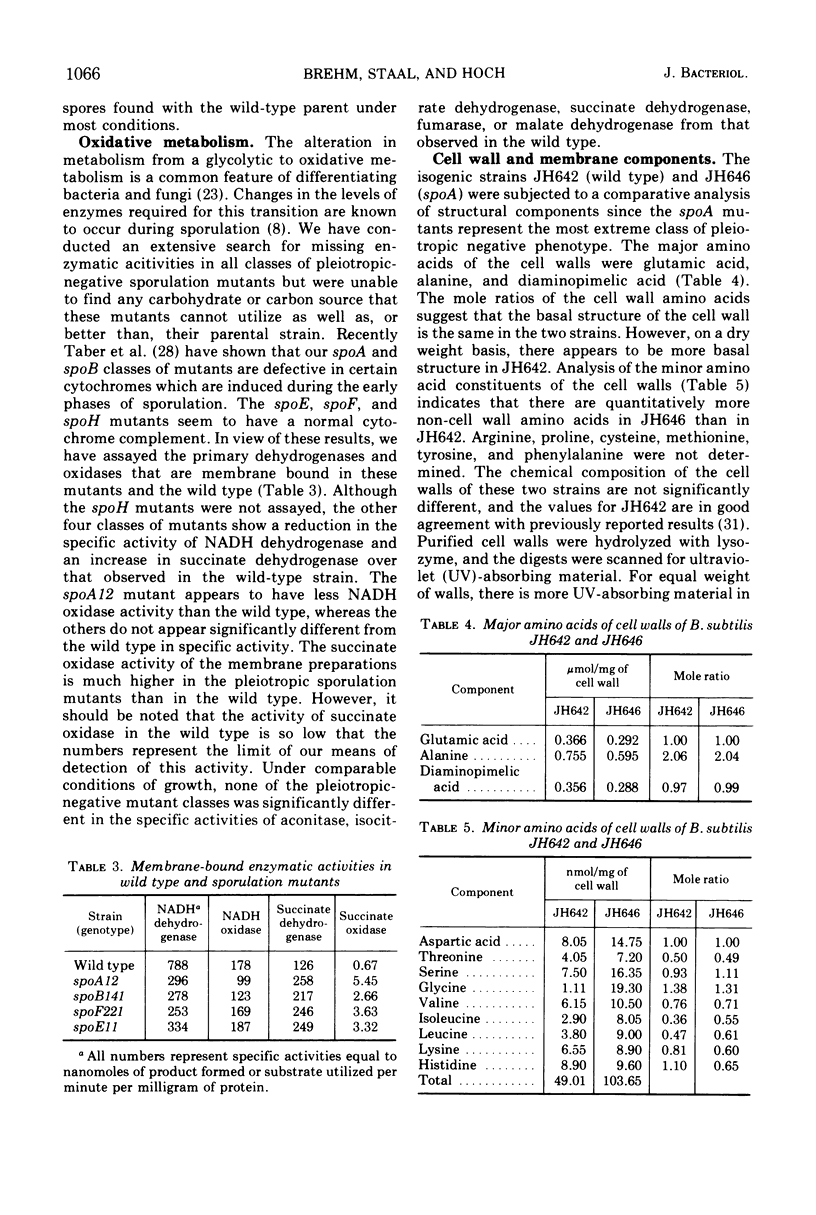Abstract
The phenotypic properties of representatives of the five genetic classes of pleiotropic-negative sporulation mutants have been investigated. Protease production, alkaline and neutral proteases, was curtailed in spoA mutants, but the remainder of mutant classes produced both proteases, albeit at reduced levels. The spoA and spoB mutants plaqued φ2 and φ15 at high efficiency, but the efficiency of plating of these phages on spoE, spoF, and spoH mutants was drastically reduced. Antibiotic was produced by the spoH mutants and to a degree by some spoF mutants, but the other classes did not produce detectable activity. The spoA mutants were less responsive to catabolite repression of histidase synthesis by glucose than was the wild type. Severe catabolite repression could be induced in spoA mutants by amino acid limitation, suggesting that the relaxation of catabolite repression observed is not due to a defect in the mechanism of catabolite repression. Although others have shown a perturbation in cytochrome regulation in spoA and spoB mutants, the primary dehydrogenases, succinate dehydrogenase and reduced nicotinamide adenine dinucleotide dehydrogenase, leading to these cytochromes are unimpaired in all mutant classes. A comparison of the structural components of cell walls and membranes of spoA and the wild type is made. The pleiotropic phenotypes of these mutants are discussed.
Full text
PDF







Selected References
These references are in PubMed. This may not be the complete list of references from this article.
- Baginsky M. L., Hatefi Y. Reconstitution of succinate-coenzyme Q reductase (complex II) and succinate oxidase activities by a highly purified, reactivated succinate dehydrogenase. J Biol Chem. 1969 Oct 10;244(19):5313–5319. [PubMed] [Google Scholar]
- Chasin L. A., Magasanik B. Induction and repression of the histidine-degrading enzymes of Bacillus subtilis. J Biol Chem. 1968 Oct 10;243(19):5165–5178. [PubMed] [Google Scholar]
- FOLCH J., LEES M., SLOANE STANLEY G. H. A simple method for the isolation and purification of total lipides from animal tissues. J Biol Chem. 1957 May;226(1):497–509. [PubMed] [Google Scholar]
- Guespin-Michel J. F. Phenotypic reversion in some early blocked sporulation mutants of Bacillus subtilis. Genetic study of polymyxin resistant partial revertants. Mol Gen Genet. 1971;112(3):243–254. [PubMed] [Google Scholar]
- HANSON R. S., SRINIVASAN V. R., HALVORSON H. O. BIOCHEMISTRY OF SPORULATION. II. ENZYMATIC CHANGES DURING SPORULATION OF BACILLUS CEREUS. J Bacteriol. 1963 Jul;86:45–50. doi: 10.1128/jb.86.1.45-50.1963. [DOI] [PMC free article] [PubMed] [Google Scholar]
- HARTWELL L. H., MAGASANIK B. THE MOLECULAR BASIS OF HISTIDASE INDUCTION IN BACILLUS SUBTILIS. J Mol Biol. 1963 Oct;7:401–420. doi: 10.1016/s0022-2836(63)80033-9. [DOI] [PubMed] [Google Scholar]
- HAY G. W., LEWIS B. A., SMITH F. THIN-FILM CHROMATOGRAPHY IN THE STUDY OF CARBOHYDRATES. J Chromatogr. 1963 Aug;11:479–486. doi: 10.1016/s0021-9673(01)80949-3. [DOI] [PubMed] [Google Scholar]
- Hanson R. S., Peterson J. A., Yousten A. A. Unique biochemical events in bacterial sporulation. Annu Rev Microbiol. 1970;24:53–90. doi: 10.1146/annurev.mi.24.100170.000413. [DOI] [PubMed] [Google Scholar]
- Higerd T. B., Hoch J. A., Spizizen J. Hyperprotease-producing mutants of Bacillus subtilis. J Bacteriol. 1972 Nov;112(2):1026–1028. doi: 10.1128/jb.112.2.1026-1028.1972. [DOI] [PMC free article] [PubMed] [Google Scholar]
- Hoch J. A. Genetic analysis of pleiotropic negative sporulation mutants in Bacillus subtilis. J Bacteriol. 1971 Mar;105(3):896–901. doi: 10.1128/jb.105.3.896-901.1971. [DOI] [PMC free article] [PubMed] [Google Scholar]
- Hoch J. A., Mathews J. L. Chromosomal location of pleiotropic negative sporulation mutations in Bacillus subtilis. Genetics. 1973 Feb;73(2):215–228. doi: 10.1093/genetics/73.2.215. [DOI] [PMC free article] [PubMed] [Google Scholar]
- Ito J., Spizizen J. Abortive infection of sporulating Bacillus subtilis 168 by phi 2 bacteriophage. J Virol. 1971 Apr;7(4):515–523. doi: 10.1128/jvi.7.4.515-523.1971. [DOI] [PMC free article] [PubMed] [Google Scholar]
- MANDELSTAM J. Induction and repression of beta-galactosidase in non-growing Escherichia coli. Biochem J. 1961 Jun;79:489–496. doi: 10.1042/bj0790489. [DOI] [PMC free article] [PubMed] [Google Scholar]
- Michel J. F., Millet J. Physiological studies on early-blocked sporulation mutants of Bacillus subtilis. J Appl Bacteriol. 1970 Mar;33(1):220–227. doi: 10.1111/j.1365-2672.1970.tb05246.x. [DOI] [PubMed] [Google Scholar]
- Millet J. Characterization of proteinases excreted by Bacillus subtilis Marburg strain during sporulation. J Appl Bacteriol. 1970 Mar;33(1):207–219. doi: 10.1111/j.1365-2672.1970.tb05245.x. [DOI] [PubMed] [Google Scholar]
- Schaeffer P. Sporulation and the production of antibiotics, exoenzymes, and exotonins. Bacteriol Rev. 1969 Mar;33(1):48–71. doi: 10.1128/br.33.1.48-71.1969. [DOI] [PMC free article] [PubMed] [Google Scholar]
- Shaw N., Baddiley J. The teichoic acid from the walls of Lactobacillus buchneri N.C.I.B. 8007. Biochem J. 1964 Nov;93(2):317–321. doi: 10.1042/bj0930317. [DOI] [PMC free article] [PubMed] [Google Scholar]
- Sutow A. B., Welker N. E. Chemical composition of the cell walls of Bacillus stearothermophilus. J Bacteriol. 1967 Apr;93(4):1452–1457. doi: 10.1128/jb.93.4.1452-1457.1967. [DOI] [PMC free article] [PubMed] [Google Scholar]
- Szulmajster J., Bonamy C., Laporte J. Isolation and properties of a temperature-sensitive sporulation mutant of Bacillus subtilis. J Bacteriol. 1970 Mar;101(3):1027–1037. doi: 10.1128/jb.101.3.1027-1037.1970. [DOI] [PMC free article] [PubMed] [Google Scholar]
- TREVELYAN W. E., PROCTER D. P., HARRISON J. S. Detection of sugars on paper chromatograms. Nature. 1950 Sep 9;166(4219):444–445. doi: 10.1038/166444b0. [DOI] [PubMed] [Google Scholar]
- VOMHOF D. W., TUCKER T. C. THE SEPARATION OF SIMPLE SUGARS BY CELLULOSE THIN-LAYER CHROMATOGRAPHY. J Chromatogr. 1965 Feb;17:300–306. doi: 10.1016/s0021-9673(00)99872-8. [DOI] [PubMed] [Google Scholar]
- YOUNG F. E., SPIZIZEN J., CRAWFORD I. P. BIOCHEMICAL ASPECTS OF COMPETENCE IN THE BACILLUS SUBTILIS TRANSFORMATION SYSTEM. I. CHEMICAL COMPOSITION OF CELL WALLS. J Biol Chem. 1963 Sep;238:3119–3125. [PubMed] [Google Scholar]


